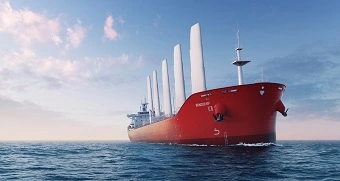Wind-Assisted Propulsion (WAP): The Future of Sustainable Shipping
02 Jun 2025 • by Natalie Aster

The maritime industry is undergoing a transformative shift as it seeks to minimize carbon emissions and boost fuel efficiency. Wind-assisted propulsion (WAP) systems are gaining traction as a viable solution, combining traditional sailing techniques with modern innovative technologies to enhance the sustainability and efficiency of shipping methods.
Wind-assisted propulsion involves the integration of devices such as rotor sails, suction wings, rigid sails, and kites onto vessels to harness wind energy, thereby scaling back the dependence on fossil fuels. These systems are designed to complement existing engines, ensuring a substantial reduction in fuel and emission levels while keeping operational efficiency intact.
Market Growth & Projections
Globally, the wind-assisted propulsion market is exhibiting a robust upturn. Valued at approximately USD 164 million last year, it is projected to go beyond USD 40 billion by 2034, expanding at an incredible CAGR of 73.47%. This surge is primarily spurred by increasing environmental regulations, rising fuel costs, and the shipping industry's commitment to decarbonization.
Driving Factors Behind Adoption
1. Environmental Norms
The International Maritime Organization (IMO) has outlined an ambitious roadmap to reduce shipping’s contribution to global emissions by at least 50% by 2050 compared to 2008 levels. Additionally, the inclusion of maritime transport in the European Union's Emissions Trading System (ETS) imposes financial incentives for emission reductions. WAP systems offer a practical means to meet these regulatory requirements by decreasing fuel consumption and associated greenhouse gas emissions.
2. Economic Benefits
Fuel remains one of the most significant operating expenditures for vessels. Implementing wind-assisted technologies can lead to fuel savings ranging from 5% to 30%, depending on the system and vessel type. In addition to cutting operating costs, these savings offer a buffer against unpredictable fuel price changes.
3. Technological Advancements
Modern WAP systems are designed for ease of integration and operation. They can be retrofitted onto existing vessels or incorporated into new builds without significant structural modifications. Automation and minimal crew requirements further enhance their appeal to shipowners and operators.
Real-world deployments:
- Pyxis Ocean: In 2023, this bulk carrier was retrofitted with BAR Technologies' WindWings, resulting in fuel savings of up to 30% during its maiden voyage.
- Grain de Sail II: A modern sail-powered cargo ship that completed transatlantic voyages with minimal emissions, showcasing the viability of wind propulsion in commercial shipping.
- SkySails System: Utilizing large kites to harness high-altitude wind energy, this system has exhibited fuel savings of almost 20% on equipped vessels.
Regional Adoption Trends
Europe: Pioneering the adoption of WAP technologies, supported by stringent environmental regulations and supportive policies. The European market is slated to reach USD 21.58 billion by 2034.
Asia-Pacific: Countries like Japan, South Korea, and China are investing heavily in wind propulsion technologies, recognizing their potential in achieving sustainability goals.
North America: While adoption is currently slower, increasing environmental awareness and regulatory pressures are expected to accelerate the uptake of WAP systems in the region.
Challenges & Considerations
Despite the promising outlook, a number of challenges need to be tackled:
- Initial Investment: The upfront costs of installing WAP systems can be substantial, potentially deterring smaller operators.
- Operational Integration: Retrofitting existing vessels requires careful planning to ensure compatibility and maintain cargo capacity.
- Regulatory Roadblocks: Lack of standardized regulations and certification processes for WAP technologies can impede widespread adoption.
The Road Ahead
As the shipping industry continues to seek sustainable solutions, wind-assisted propulsion stands out as a practical and effective approach. With ongoing technological advancements, supportive regulatory frameworks, and growing environmental consciousness, WAP systems are poised to play an essential role in the future of maritime transport.
Research Report:
Wind-Assisted Propulsion Market - A Global and Regional Analysis: Focus on Application, Technology, Installation Type, Vessel Type and Country-Level and Regional Analysis - Analysis and Forecast, 2024-2034
Published: June 2025
Pages: 133
Market Publishers boasts a rich collection of insightful research studies covering the energy market, find it in the Energy Market Reports Catalogue.
CONTACTS
The Market Publishers, Ltd.
Natalie Aster
Tel: +357 96 030922
[email protected]
MarketPublishers.com
Analytics & News
